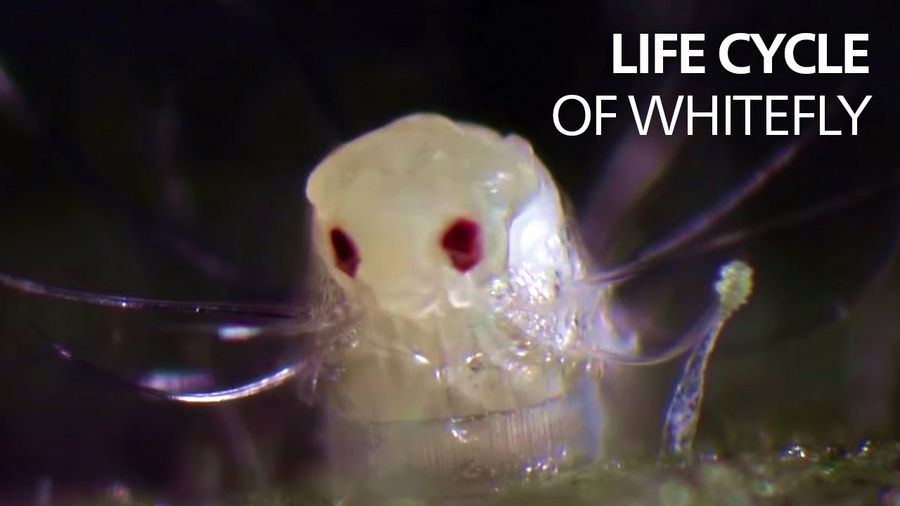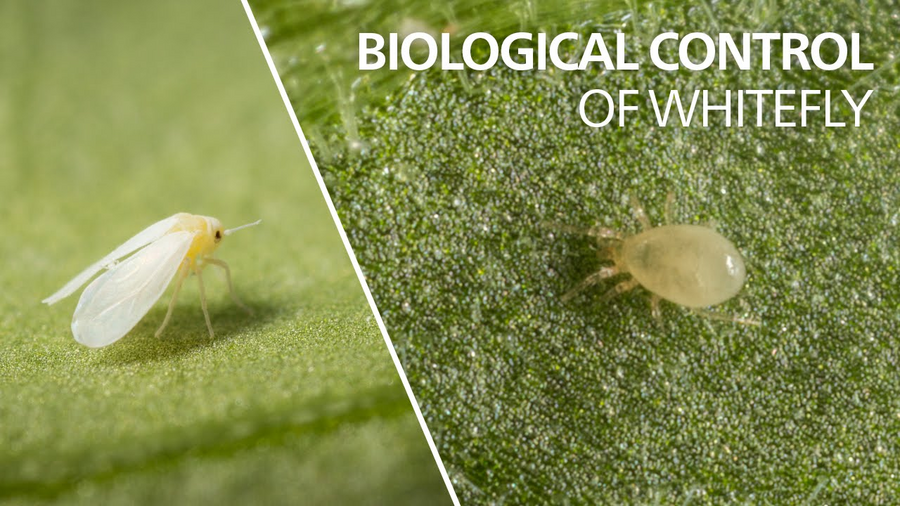


Was sind Weiße Fliegen?
Die Weiße Fliege ist keine echte Fliege, sondern gehört zur Ordnung Hemiptera (Schnabelkerfe). Zusammen mit Blattläusen und Schildläusen gehört sie zur Unterordnung Sternorrhyncha. Die Weißen Fliegen bilden die Familie der Mottenschildläuse (Aleyrodidae). Die häufigsten Arten sind die Gewächshaus-Weiße Fliege (Trialeurodes vaporariorum) und die Tabak-Weiße Fliege (Bemisia tabaci). Beide sind weit verbreitet, polyphag und in groben Zügen weitgehend vergleichbar.
Recognize whitefly
Whiteflies can be identified by the following characteristics:
- Size and shape: Whiteflies are small, winged insects that are typically about 1-2 mm in length. They have a distinctive, triangular shape and hold their wings in a vertical position over their body when at rest.
- Color: As their name suggests, whiteflies are usually white or pale yellow in color. This is due to the wax produced by the adults, which is covering their body and wings. Some species have dark markings on their wings or bodies.
- Movement: Whiteflies are weak fliers and tend to flutter around plants rather than fly in a straight line. They are often found on the undersides of leaves, where they feed on plant sap.
- Damage: Whiteflies can cause damage to leaves by feeding on plant sap. This can result in yellowing, wilting, or premature leaf drop.
If you suspect that you have a whitefly infestation, it's important to confirm their presence and take appropriate measures to control their population.
Schäden durch Weiße Fliege
Die Larven benötigen für ihr Wachstum viele Nährstoffe und nehmen daher große Mengen an Pflanzensaft auf. Dieser enthält einen hohen Zuckeranteil, und der Überschuss wird als Honigtau ausgeschieden, wobei größere Larven größere Mengen ausscheiden. Dies kann die folgenden Konsequenzen haben:
- Wenn der Befall sehr groß ist, kann die Physiologie der Pflanze beeinträchtigt und das Wachstum gehemmt werden. In vollem Sonnenlicht welken die Blätter und fallen ab. Ein solcher Blattschaden kann sich wiederum auf die Entwicklung der Frucht auswirken und den Ertrag mindern.
- Durch das Saugen von Pflanzensaft und die Absonderung von Honigtau verringert die Weiße Fliege den ästhetischen Wert von Pflanzen. Dies ist insbesondere bei Zierpflanzen ein wichtiger Aspekt.
- Der ausgeschiedene Honigtau verklebt die Früchte. Dadurch bleibt Schmutz an ihnen haften und die Bildung von Rußtau (Cladosporium spp.) wird gefördert. Diese Früchte sind nicht mehr verkäuflich. Bei schwerem Befall kann die Frucht faulen. Rußtau bildet sich auch auf den Blättern und behindert die Photosynthese und Transpiration.
- Viren können von einer Pflanze auf eine andere übertragen werden. Sowohl T. vaporariorum als auch B. tabaci sind dafür bekannt, Viren zu übertragen.
How to prevent whitefly
To prevent whitefly infestations in crops, there are several measures you can take:
Implement good crop management practices
Maintain plant health by providing proper irrigation, nutrition, and adequate spacing between plants. Healthy plants are less susceptible to whitefly infestations.
Practice strict hygiene
Keep the growing area clean and free from debris, weeds, and plant residues that can serve as reservoirs for whiteflies. Regularly remove and dispose of any infested plant material.
Monitor regularly
Regularly inspect your crops for signs of whiteflies, including adult insects, nymphs, or their characteristic sticky honeydew. To aid in monitoring, strategically position sticky traps throughout the crop to capture adult whiteflies and provide insight into population levels. Early detection allows for prompt action and prevents the infestation from spreading.
Use physical barriers in greenhouses
Install insect-proof screens on openings such as vents and doors to prevent whiteflies from entering the crop area. This helps create a physical barrier and reduces the chances of infestation.
Introduce biological control agents
Utilize natural enemies of whiteflies such as parasitic wasps, predatory mites, predatory bugs, or entomopathogenic fungi. These beneficial organisms can help control whitefly populations by feeding on them or their eggs.
Rotate crops and plant diversity – outdoor crops
Avoid continuous cropping of susceptible plant species. Rotate crops to disrupt whitefly life cycles and reduce the buildup of infestations. Additionally, planting a diverse range of crops can create an environment less favorable for whiteflies.
Videos zur Bekämpfung von Weißer Fliege
Schauen Sie sich das Video an oder besuchen Sie unseren Youtube-Kanal, um unsere Produkte zur Bekämpfung von Weißer Fliege in Aktion zu sehen.
































